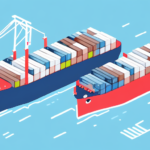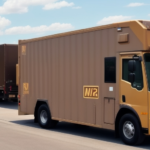Understanding UPS Mail Shipping Rates
UPS is one of the most popular shipping carriers globally, renowned for providing reliable and efficient delivery services to customers worldwide. However, understanding their shipping rates can be a confusing and daunting task, with various factors and variables influencing the costs. This article aims to break down the components of UPS mail shipping rates to help businesses and individuals make informed decisions and keep their shipping costs in check.
Breaking Down the Components of UPS Mail Shipping Rates
UPS mail shipping rates are determined by several factors, including package weight and size, delivery speed, destination, and value. The three primary components that make up UPS mail shipping rates are:
- Base Rate: This is the standard rate charged for shipping a package based on its weight and destination.
- Fuel Surcharge: UPS charges a fuel surcharge to account for fluctuating fuel prices, which directly affect transportation costs.
- Additional Charges: These include fees for various services, such as pickup, processing, and delivery to remote or rural areas.
Moreover, UPS offers discounts for high-volume shippers and businesses that utilize their online shipping tools. These discounts can range from a percentage off the total shipping cost to waived fees for certain services. Additionally, UPS provides insurance options for packages, adding an extra cost to the shipping rate. It's crucial to consider all these factors when determining the total cost of shipping with UPS.
How UPS Determines Shipping Rates for Different Packages
The base rate for UPS mail shipping is determined by the package's weight and the distance it travels, with the actual shipping cost calculated based on a combination of these two factors. Delivery speed is another significant component, with faster delivery options typically costing more than slower ones.
UPS offers various shipping options, such as ground, air, and international services, each with different rates. Understanding these options is essential to choosing the one that best fits your shipping needs and budget.
Additionally, UPS considers the package's dimensions when determining shipping rates. Packages that are larger in size may incur additional fees, known as dimensional weight charges. This means that even if a package is relatively light, it may still be charged at a higher rate if it occupies significant space in the delivery vehicle.
The Impact of Package Weight and Size on UPS Mail Shipping Rates
The weight and size of a package are critical factors in determining UPS mail shipping rates. Generally, the heavier and larger the package, the more expensive it is to ship. For instance, a 5-pound package will cost less to ship than a 20-pound package traveling to the same destination.
UPS enforces package size restrictions, with additional charges for oversized packages. Accurately measuring your package and choosing the right shipping option can help avoid unnecessary costs.
The shape of the package also affects shipping rates. UPS calculates the dimensional weight of a package based on its length, width, and height. If the dimensional weight exceeds the actual weight, shipping rates are based on the dimensional weight. Therefore, choosing packaging that minimizes empty space can help reduce shipping costs.
Understanding UPS's Shipping Zones and How They Affect Rates
UPS divides the United States and the rest of the world into different shipping zones, each with its base rate. Zones closer to your location typically have lower base rates than those farther away, impacting overall shipping costs. Understanding these shipping zones is essential for accurately estimating your shipping costs and selecting the most cost-effective option.
When shipping internationally, UPS categorizes countries into different zones, each with its base rate. The distance between the origin and destination countries, as well as customs regulations and duties, can affect shipping costs. Researching and understanding the shipping zones and customs regulations of the destination country can help avoid unexpected fees and delays.
UPS also offers a service called UPS My Choice, which allows customers to customize their delivery options and reroute packages to a different address or pick-up location. This service can be especially beneficial when shipping to locations in higher shipping zones, potentially providing more cost-effective delivery options.
The Role of Delivery Speed in UPS Mail Shipping Rates
The speed of delivery significantly affects UPS mail shipping rates. Faster delivery options, such as overnight or same-day shipping, are more expensive compared to standard ground shipping.
Delivery speed also depends on the destination. Shipping to a remote location may take longer, even with expedited options. In such cases, it's advisable to consult with UPS for accurate delivery time estimates and costs.
The time of day when you drop off your package can also influence delivery speed. Dropping off a package after the cutoff time may result in processing delays, potentially delaying delivery. To ensure timely delivery, it’s best to drop off packages well before the cutoff time.
Hidden Costs to Watch Out for When Using UPS Mail Shipping
UPS mail shipping may include hidden costs that can lead to unexpected expenses for businesses and individuals. Some of these hidden costs include:
- Additional handling fees for fragile or oversized packages.
- Surcharges for residential delivery or delivery to locations without a loading dock.
- Returns processing fees.
- Re-delivery fees if no one is available to receive the package.
Being aware of these hidden costs and incorporating them into your shipping budget can help avoid unforeseen expenses.
Another hidden cost is the fuel surcharge, which varies depending on current fuel prices and can significantly increase shipping costs, especially for long-distance or international shipments.
Additionally, UPS offers optional services such as signature confirmation or insurance, which add to the shipping cost. While these services provide added security and peace of mind, they come at an extra cost that should be factored into your shipping method decision.
Tips and Strategies for Saving Money on UPS Mail Shipping Rates
Although UPS mail shipping rates can be perceived as expensive, several strategies can help reduce shipping costs:
- Use the correct packaging material and size to avoid additional fees.
- Choose the most cost-effective shipping option based on delivery speed and destination.
- Utilize UPS's online tools to estimate your shipping costs in advance.
- Purchase shipping labels and prepay for shipping to secure discounts.
- Consolidate multiple packages into a single shipment to save on shipping costs.
Additionally, take advantage of available discounts or promotions. UPS offers discounts for small businesses, non-profit organizations, and frequent shippers. Signing up for UPS My Choice can also provide access to exclusive discounts and promotions. Regularly reviewing your shipping invoices ensures you are charged correctly and helps identify areas to further reduce costs.
Understanding the Differences Between Retail and Online UPS Mail Shipping Rates
UPS provides different pricing options for retail and online customers, each with varying rates. Online customers often benefit from discounted rates, making it essential to understand these differences to choose the most economical option.
One significant difference between retail and online UPS mail shipping rates is the calculation method. Retail rates are typically based on the weight and size of the package, as well as the distance it needs to travel. In contrast, online rates often consider a combination of factors, including the package's weight and size, shipping destination, and selected shipping speed.
Comparing UPS's Shipping Rates to Other Major Carriers like FedEx and USPS
While UPS is a leading shipping carrier, it's crucial to compare its rates with other major carriers such as FedEx and USPS. Each carrier has a unique pricing structure, with different rates for various shipping options and destinations. Comparing shipping rates can help you make informed decisions and select the most cost-effective option for your shipping needs.
How to Use UPS's Online Tools to Estimate Your Shipping Costs Ahead of Time
UPS offers a range of online tools to help estimate your shipping costs in advance, including shipping calculators, rate charts, and comparison tools. Utilizing these tools enables you to estimate shipping costs accurately, plan your budget, and choose the most cost-effective shipping option.
Navigating the Fine Print: Understanding Terms and Conditions for UPS Mail Shipping Rates
UPS mail shipping rates come with specific terms and conditions that must be understood to avoid unexpected expenses or delays. These terms include package restrictions, delivery guarantees, return policies, and claims procedures. It's essential to read and understand these details to ensure smooth and cost-effective shipping.
Best Practices for Managing Your Business's Shipping Costs with UPS
Effective management of shipping costs is critical for businesses that rely on UPS for their shipping needs. Some best practices include:
- Choosing the right shipping option based on needs and budget.
- Negotiating rates with UPS for high-volume or regular shipments.
- Utilizing UPS's online tools to estimate shipping costs and manage expenses.
- Consolidating multiple packages into a single shipment to save costs.
- Automating the shipping process to reduce errors and save time and money.
Conclusion: Making the Most of Your Knowledge About UPS Mail Shipping Rates
Understanding UPS mail shipping rates empowers businesses and individuals to make informed decisions, save money, and avoid unexpected expenses. By breaking down the components of UPS mail shipping rates, exploring hidden costs, and implementing best practices, you can efficiently manage your shipping costs and select the most cost-effective shipping options for your needs. With this knowledge, you can optimize your shipping experience with UPS and enhance your overall logistics strategy.




















